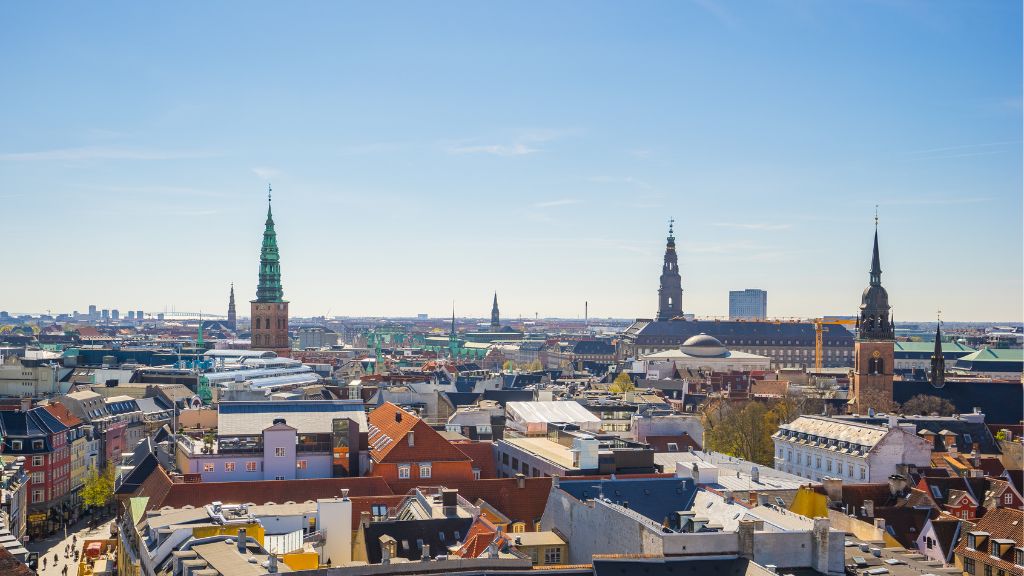
Amalienborg
Amalienborg is the winter residence of the Danish royal family. Well, actually the royal palace is not one, but four different palaces flanking a square. The four palaces where built by four noble families in the middle of the 18th century on direct orders by the king Frederik V.
The King needed a new royal palace but he didn't want to pay so the four families were given tax immunity for 40 years as token for their services to the crown. In 1794 the royal family moved into the four palaces around the square which is considered to be one of the great masterpieces of Rococo architecture in Europe, and definitively the best one in Denmark. The statue in the middle of the square was sculptured by the French artist Saly.
Every day at noon, you can watch the change of guards in the court yard. When HM the Queen is in residence, the ceremony is called The King's Watch (Kongevagt) and the guards are accomopanied by the Royal Guards music band. The route, that starts at 11:31 at the barracks, goes: Rosenborggade, Købmagergade, Østergade, Kongens Nytorv, Bredgade, Sct. Annæ Plads, Amaliegade, and Amalienborg.
If one of the Royal Princes is residing at the palace in the capacity of regents, the parade is called The Lieutenant Watch, and drums and flutes will be heard.
In other cases (when the palace is not inhabited or the princes are at home but not in the capacity of regent) the Guards march through Copenhagen without music accompaniment, and the route is shorter. This watch is called The Manor Watch.
Christiansborg
Christiansborg Palace is the most important building in Denmark today. It is the centre of Danish democracy as the seat of the Folketinget (the Danish Parliament), the Supreme Court, the Prime Minister's office, and the Royal Reception Rooms.
Christiansborg is situated in the small Slotsholmen, the Palace Island, and for almost a thousand years this has been the site for parliament and sovereigns ever since the times of Arch Bishop Absalon, in the 12th century. He erected the first palace in Slottsholmen, which stood over 200 years, unitl it was demolished by the Hanseatic cities.
During the centuries to come, kings have been crowned an married in the royal palaces on this site where palaces has been erected, burnt down and erected again. The last fire was in 1884.
The palace of today dates back to the beginning of the 20th century and is built on the ruins of the former royal palaces. Parts of the palace is opened to public.
Fredriksberg
The royal palace of Frederiksberg dates back to 1699 when the crown prince Frederik built himself a smaller summer palace. But when he inherited the throne a few years later, he wanted a grander building.
Said and done: in 1703 the grander palace stood ready. At the same time the road leading up to the palace was laid out as a private road for the royal family and it wasn't until 1862 that the road opened to public.
The king just loved his palace so much that he hardly ever visited Copenhagen, although it was just a few kilometres away.
The interiors of the palace are very well preserved and many of the state rooms haven't changed since the time of Frederik V. The palace's church dates back to 1734. The palace museum houses a large collection of portraits and belongings illustrating the history of palace. The park surrounding the palace, Frederiksbergs Have is one of the most beautiful parks in northern Europe.
Rosenborg
The Rosenborg Park is called the Kongens Have (The King's Garden), a very popular oasis to Copenhageners and visitors.
In the beginning of the 17th century king Christian IV planned a new garden a couple of kilometres from the centre of Copenhagen. But influenced by the new trends in other royal courts in Europa, he decided to build himself a summer residence, Rosenborg. With inspiration from Versailles the king even installed his own private bathroom and what was called "the King's secret room".
Today Rosenborg is right in the centre of the city and opened to public. The main attraction is the crown jewels and the crown regalia which are part of the De Danske Kongers Kronologiske Samlinger (Royal Danish Chronological Collections) including everything from paintings, chinaware to silver.













